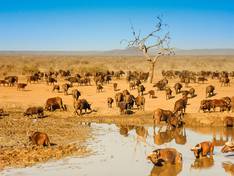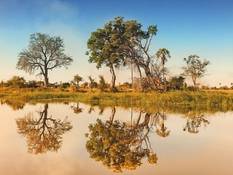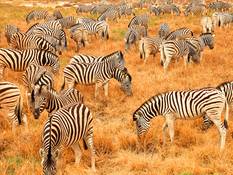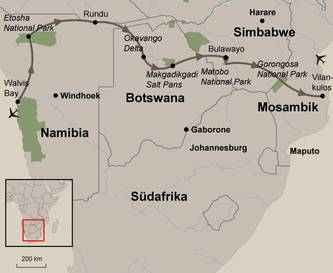Coast to Coast Tour
Cross the African continent from the cold Atlantic Ocean on the west coast to the warm Indian Ocean on the east coast including the Okavango Delta, visiting Namibia, Botswana, Zimbabwe and Mozambique
Join us on this truly magnificent journey across Southern Africa – from the west coast to the east coast. From the hot and dry Namib Desert on the Atlantic coastline of Namibia to the tropical shores of Mozambique, you will encounter the most enchanting highlights of four countries. On this exclusive tour you will explore the ancient history of Zimbabwe and the natural splendours of Botswana. Enjoy this absolutely unique 22 day journey in the luxury of a small group, in a comfortable touring vehicle, together with a highly knowledgeable and experienced local tour guide. Meet diverse people of different origins, religions and cultures. Let us take you on this once in a lifetime adventure, right across the southern part of the African continent – from Coast to Coast.
Highlights
- Travel in a small group (four to eight people)
- Discover the creatures of the worlds oldest Desert, the Namib
- Experience Bushman culture and their paintings at Spitzkoppe and in the Matobos
- Observe the animal herds of Etosha National Park
- Explore the peaceful Kavango River and the life it supports
- Immerse yourself in the wildlife paradise of the Okavango Delta
- Watch the full moon rise over the world’s largest salt pans – Makgadikgadi
- Encounter ancient African civilizations at the city of Great Zimbabwe
- Meet a cultural guardian of the Shona people
- Visit Gorongosa National Park – the flagship park of Mozambique rising from the ashes
- Dive into the warm tropical waters of the Indian Ocean at Vilankulos
Tour Description
Day 1: Departure
Your trip begins with your flight to Namibia.
Day 2: Welcome to Namibia
Arrive at Walvis Bay International Airport in Namibia, where your tour guide will welcome you. Our first destination is your beautiful guest house with a pool and sea view in Swakopmund where you will stay for the next two nights. Swakopmund, famous for its beautiful German colonial architecture, is a popular holiday destination for Namibians. Before dinner, join us for a sundowner drink on the dunes overlooking the icy Atlantic Ocean – a perfect start for our “Coast to Coast Tour”.
51 km / D
Day 3: Where the desert dunes meet the Atlantic
The morning is at leisure in Swakopmund. You may like to join us on an optional boat cruise in Walvis Bay or alternatively explore the charming town of Swakopmund and do some last minute shopping before we embark on the adventure of a lifetime. In the afternoon an interesting tour awaits us, where we will explore the Namib Dunes together with a local biologist who will show us the many creatures that inhabit this seemingly inhospitable desert. From the highly adapted plants, to an astounding variety of insects, reptiles and other desert denizens, we will experience this “Living Desert”. In the evening a mouth-watering dinner awaits us in a restaurant overlooking the cold Atlantic Ocean.
76 km / B, D
Day 4: Ancient Art - the Spitzkoppe Mountains
We depart in a north westerly direction from the Atlantic Coast. We will visit Namibia's famous Spitzkoppe mountain. The Spitzkoppe (from the German for "pointed dome") is a group of bald granite outcrops or inselbergs located the Damaraland region. The granite is more than 700 million years old and the highest outcrop rises about 1,784 meters above sea level, standing out dramatically from the flat surrounding plains. We will explore the spectacular rock formations and see paintings left behind by Bushman people that lived in this area between 4,000 and 6,000 years ago. In the afternoon we drive through the dry savannah to our accommodation for the night, Ugab Terrace Lodge, uniquely situated on a hilltop with breathtaking views in all directions.
385 km / B, D
Day 5: Zebras Crossing - Etosha National Park
In the morning our journey takes us further north west to the southern entrance of the world famous Etosha National Park. Covering an area of 22,275 square kilometres, this national park is one of the largest in Africa and is home to a huge variety of large and small game species. During our game drives we might be lucky enough to spot the herds of zebra, springbok or blue wildebeest that Etosha is famous for. We will also be looking for lions, giraffe, rhinos and many other animals and birds. We will spend the night in comfortable chalets at Okaukuejo Rest Camp. The camp boasts a restaurant with excellent game dishes, where we will enjoy our dinner, before going to the flood lit waterhole, where it is possible to watch the nocturnal activity of the wildlife for as long as you like.
203 km / B, D
Day 6: A German Fort and the Great White Place
The name “Etosha” derives from the Oshivambo language and means “great white place”. It refers to an immense salt pan, covering an area of 5000 square kilometres. We will see the pan during our full day exploring the park, visiting various waterholes that are favoured by elephants and other thirsty animals. There are 114 mammal, 340 bird, 110 reptile and 16 amphibian species living in the park. By sunset we will be in Namutoni, the old German fort from colonial times. Here we spend the night in comfortable chalets.
134 km / B, D
Day 7: Tracking the Bushmen - Culture in Depth
We may take a short game drive before breakfast if you like, to visit a last waterhole or two. About two hours after leaving the park via Anderson Gate, we reach a remote village called Tsintsabis. After the independence of Namibia, Reinhard Friedrich issued a piece of land to a bushman clan. He stayed there with them, learning about their culture and language. We will accompany Mr Friedrich on the unique Muramba Bushman Trail, while he shares his extensive knowledge about the way of life of the bushman people. In the afternoon our three hour drive to Rundu, right on the northern border of Namibia, passes through many traditional villages. Our lodge is situated right on the Kavango river, which forms the border to Angola. Valerie’s home cooked supper will be the perfect end to the day.
366 km / B, D
Day 8: The People of the Kavango River
After breakfast we embark on a visit to the local community, an unrivalled cultural experience. A local guide will introduce us to the daily lives of the Kavango people. Warm smiles and friendly faces await us as we meet families living in their traditionally built huts and learn about the special relationship of these people with the river that is their life line. In the afternoon we return to the lodge to relax a while, before taking a boat cruise on the Kavango River to enjoy the peaceful atmosphere and a sundowner on the water. After dinner, listen for the rhythm of African drums and dances, symbolising the strength and unity of the people.
0 km / B, D
Day 9: Happy Hippos
We head into the Zambezi Region, formerly known as the Caprivi Strip, before turning south into the Mahangu National Park. We could see buffalo, rhino or elephant here, as well as many antelope species. The extremely rare sable antelope occurs here, and with a lot of luck we may even catch a glimpse of one. Around midday we cross the border into Botswana. In Shakawe we catch a boat to our lodge on the Okavango River. We spend the night in luxurious safari tents, right on the river bank. At night, you might hear the characteristic grunting laugh of the hippo, or even see one as it comes out of the water to graze.
250 km / B, D
Day 10: Fly into Paradise - the Okavango Delta
A short boat ride returns us to our vehicle. We head further south to the rapidly expanding town of Maun – Gateway to the Okavango Delta. This unique wildlife paradise is created by the Okavango river. After 1,600 kilometres the river reaches the Kalahari desert and fans out to form the 6000 square kilometre delta, before sinking into the ground. From Maun we will fly to our lodge in the Okavango Delta. We spend the next two nights in luxuriously appointed safari tents in the heart of this magical landscape. Listen for the haunting cry of the African fish eagle, a signature sound of Africa.
377 km / B, D
Day 11: Waterways and Wildlife – A Mokoro Experience
We will take an early morning trip in traditional dugout canoes called Mokoros. An expert poler will ensure that you move around the shallow waters of the delta in safety and comfort, and point out animals and birds along the way. Beside the abundant wildlife, the birds of the delta are magnificent. Stately crowned cranes, the bejewelled malachite kingfishers and the comical African spoonbills are common here, among many others. Upon our return a delicious brunch will be waiting for us. In the afternoon we will head off to explore more of the delta, this time on an open safari jeep. We might spot the rare sitatunga antelope, while hippos and crocodiles are common residents of the delta.
0 km / B, D
Day 12: Makgadikgadi Pans – Full Moon Rising
After flying back to Maun we drive across the largest salt pans on the planet, the endless Makgadikgadi Pans. They cover an area the size of Belgium. The road passes through an ever changing landscape of flat grasslands dotted with ancient baobab trees, and stark white salt flats, stretching further than the eye can see. In the evening we will take a walk and watch the full moon rise in this surreal pan. We spend the night in a lodge situated near the eastern edge of the pan.
311 km / B, D
Day 13: Into Zimbabwe - Busy Bulawayo
Today we cross the border into Zimbabwe. Around lunchtime we reach Bulawayo, the capital of Matabeleland. A short stop in the bustling city centre might include a quick visit to the famous railway museum if you are interested, or alternatively a cup of coffee or tea for refreshment. Just an hour’s drive south brings us to the world famous Matobo Hills. This is rated one of Southern Africa’s most dramatic landscapes with impressive granite rock formations rising out of the surroundings and interspersed with blocks of granite piled on top of each other in gravity defying pillars and stacks. Our comfortable lodge is situated on a granite whaleback. A sundowner overlooking the fantastic Matobos vista is a fitting end to the day.
399 km / B, D
Day 14: Matobos National Park – View of the World
The Matobo National Park, a UNESCO World Heritage Site, is a place of outstanding natural beauty, where granite is the building material and weather is the artist! We spend the morning exploring the park and visiting some of the rock overhangs which have sheltered the world’s most ancient people for 40,000 years. Their paintings and decorations have survived to this day and we will be able to see some of them. We will also visit the famous “View of the World” where the grave of Africa’s most famous imperialist Cecil John Rhodes is situated. This afternoon there is time for an optional game drive in the wildlife preserve of the National Park if you like, or alternatively spend some time relaxing at the pool or taking a walk around the granite outcrops at the lodge. Dinner will be served in the beautiful lodge restaurant.
68 km / B, D
Day 15: Great Zimbabwe – Houses of Stone
After breakfast we head east towards Masvingo. Another UNESCO World Heritage Site is on the program for today: the Great Zimbabwe National Monument. It is believed that the first stone structures were erected here around AD1100. This magnificent ruined city on its 722ha site is the largest stone structure ever built south of the Sahara and the name Zimbabwe derives from the Shona words “dzimba dza mabwe” meaning “houses of stone”. The strange carved soapstone birds that were found here have provided the country with its national symbol, found on the national flag. After a fascinating tour around this area we go to our nearby guesthouse, located on a hillside with a lovely view over Lake Mutirikwe. The beautiful gardens invite you to relax for a while, before enjoying a home cooked dinner.
357 km / B, D
Day 16: Shona Culture in the Eastern Highlands
The Eastern Highlands of Zimbabwe are our next destination. This area is known for its lush vegetation, uncommon bird species, as well as the samango monkey, which prefers isolated and indigenous forest areas. We will spend the next two nights at our beautiful mountain lodge, situated in the Eastern Highlands. After checking in we will go and visit a guardian of the Shona culture. He will offer us fascinating insights to the beliefs and traditions of the local people and share his vast knowledge about some endemic plants and their medicinal uses. Breathtaking views and unique vegetation are the rewards waiting for us along a two to three hour hike this afternoon. We will also keep our eyes peeled for some of the unusual bird species that are at home in this landscape. We return to the lodge in time for a sundowner before dinner.
320 km / B, D
Day 17: Tobacco Growers Incorporated
In the morning we visit a tobacco farming cooperative with 2800 members. Tobacco has always been one of Zimbabwe’s most important products and here is an example of how several hundred small scale farmers can be a part of this large scale export market. It offers an interesting look into the economic development that is happening in many parts of Southern Africa. Afterwards we will take a scenic drive in the Bvumba Mountains.
120 km / B, D
Day 18: Gorongosa National Park - Phoenix from the Ashes
It is only a short drive from Mutare to the border of Mozambique and after clearing immigrations and customs we enter the fourth country on our epic journey. In 2004 a restoration project for Gorongosa was started by Gregory Carr and the Mozambique government, to restore the national park to its former glory after the war. Great progress has been made and this beautiful park is a fantastic example of how community and wildlife can benefit each other. 20% of all proceeds from tourist activities in the area are given directly to the communities living around the park. In the afternoon we will go on a game drive, to see the herds of buffalo and antelope. With some luck we might also encounter lion and elephants. We overnight in comfortable chalets at the main tourist camp,Chitengo.
233 km / B, D
Day 19: Vilankulo - A Continent has been Crossed
One last drive south brings us over the Save River to the Indian Ocean. From coast to coast – we have reached the east coast of Africa. We stop for a quick swim at Inhassoro, before continuing on to Vilankulo, Mozambique’s most important tourist destination. Our lodge overlooks a palm fringed beach washed by the tropical waters of the Indian ocean. Nearby mangrove forests harbour many birds, such as egrets, terns, gulls and other waders. The azure waters invite a refreshing swim before a delicious seafood dinner.
473 km / B, D
Day 20: Dive into it - the Tropical Indian Ocean
Today there is time to enjoy the tropical waters of Vilankulo. Our lodge is situated right on a beautiful beach, with good opportunities for swimming and relaxing on the beach or at the pool. You can also visit Machilla Magic, a market that sells excellent crafts made by 50 local families for some souvenirs to take back home. If you like you can join us on an optional full day boat trip to the beautiful Two Mile Reef. We will end our epic coast to coast adventure with a candle lit seafood dinner on the beach, looking back over shared highlights and experiences from our journey.
0 km / B, D
Day 21: An Adventure Comes to a Close
After a leisurely breakfast and perhaps a last swim in the warm Indian Ocean, we will drive to Vilankulo airport. From here your flight takes you to OR Tambo International Airport in South Africa and your connecting flight back home.
5 km / B
Day 22: Welcome Home
Today you arrive back in your home country.
Prices and Tour Dates
Tour Price:
Prices and Dates on request.
Tour Dates:
Prices and Dates on request.
* The quoted rates are valid for groups of 6 to 8 people.
* We will confirm 28 days before departure at latest that the minimum group size has been met.
* General increases of travel costs and varying exchange rates are excluded from the quoted price.
* Tour itinerary and program is subject to change on short notice due to circumstances, weather etc.
Price includes:
- Private, local, qualified tour guide for the entire trip from Walvis Bay, Namibia to Vilankulo, Mozambique.
- 19 nights in selected 3 to 4 star graded accommodation
- Breakfast and dinner on all days excluding beverages (B = Breakfast / L = Lunch / D = Dinner)
- Modern tour bus with A/C for all activities and round trip
- All entrances, road fees, activities and park fees as detailed in tour description (except optional activities)
- Luggage transport
Price does not include:
- Long haul flights to Namibia and from Mozambique
- Optional activities and additional services
- Travel insurance
- Visa Fees (Zimbabwe, Mozambique)
- Beverages, tips and expenses of a personal nature





